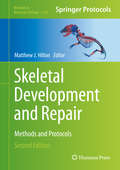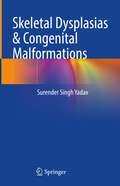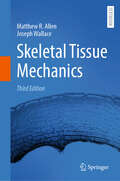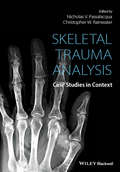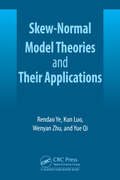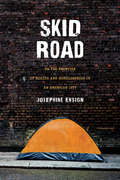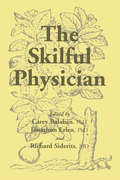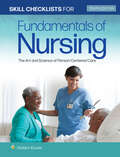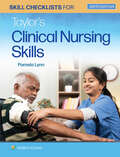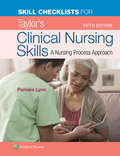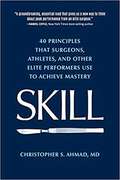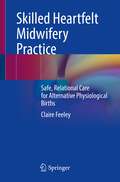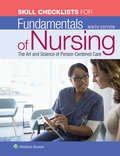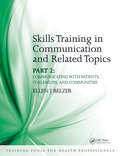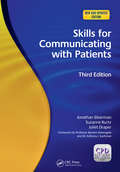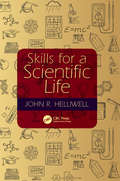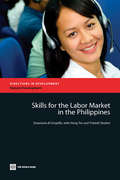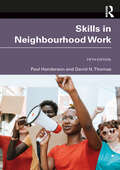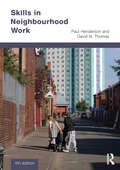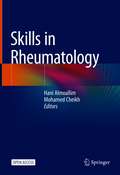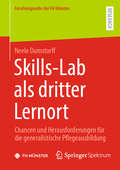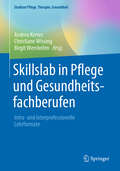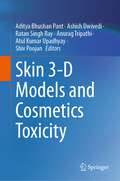- Table View
- List View
Skeletal Development and Repair: Methods and Protocols (Methods in Molecular Biology #2230)
by Matthew J. HiltonThis second edition provides a comprehensive laboratory manual on skeletal development and skeletal repair research utilizing mouse models. Chapters provide methods and protocols on the most current and cutting-edge techniques in skeletal development and repair, histological, cellular, and molecular techniques. Written in the highly successful Methods in Molecular Biology series format, chapters include introductions to their respective topics, lists of the necessary materials and reagents, step-by-step, readily reproducible laboratory protocols, and tips on troubleshooting and avoiding known pitfalls. Authoritative and cutting-edge, Skeletal Development and Repair: Methods and Protocols-Second Edition aims to ensure successful results in the further study of this vital field.
Skeletal Dysplasias & Congenital Malformations
by Surender Singh YadavThis book presents significant clinical and radiological descriptions with photographic details of common and rare Skeletal Dysplasias and Congenital Malformations. It simplifies and classifies skeletal dysplasias and other orthopedic congenital anomalies with the help of a collection of complex cases.It contains 1195 images (404 Coloured). It also explains the simple and systematic approach to correct diagnosis and adequate management of such patients. All types of congenital anomalies of the musculoskeletal system are included, some of them treated.This book assists PG students in the Department of Orthopaedics, Paediatrics, and Radiology. It is also helpful as a ‘Reference Book’ for the concerned Medical teachers, Researchers, General Practitioners, and all others interested. The book will also benefit the parents of such children for correct diagnosis and required management.
Skeletal Tissue Mechanics
by R. Bruce Martin David B. Burr Neil A. Sharkey David P. FyhrieThis textbook describes the biomechanics of bone, cartilage, tendons and ligaments. It is rigorous in its approach to the mechanical properties of the skeleton yet it does not neglect the biological properties of skeletal tissue or require mathematics beyond calculus. Time is taken to introduce basic mechanical and biological concepts, and the approaches used for some of the engineering analyses are purposefully limited. The book is an effective bridge between engineering, veterinary, biological and medical disciplines and will be welcomed by students and researchers in biomechanics, orthopedics, physical anthropology, zoology and veterinary science. This book also: Maximizes reader insights into the mechanical properties of bone, fatigue and fracture resistance of bone and mechanical adaptability of the skeleton Illustrates synovial joint mechanics and mechanical properties of ligaments and tendons in an easy-to-understand way Provides exercises at the end of each chapter
Skeletal Tissue Mechanics
by Joseph Wallace Matthew R. AllenThis textbook describes the biomechanics of bone, cartilage, tendons and ligaments. It is rigorous in its approach to the mechanical properties of the skeleton yet it does not neglect the biological properties of skeletal tissue. Time is taken to introduce basic mechanical and biological concepts, and the approaches used for some of the engineering analyses are purposefully limited. The book is an effective bridge between engineering, veterinary, biological and medical disciplines and will be welcomed by students and researchers in biomechanics, orthopedics, physical anthropology, biological science, medical science, and veterinary science. This third edition includes a new chapter on the history of skeletal tissue structure and function, updated content across chapters and recent suggested readings.
Skeletal Trauma Analysis: Case Studies in Context
by Nicholas V. Passalacqua Christopher W. RainwaterIn the post-Daubert era, forensic science disciplines are increasingly informed by robust, statistically-sound experimental research. The educational value of the well-documented case study, however, remains as important as ever. Emphasizing known contextual information, this volume serves as a case-driven guide to skeletal trauma analysis through the unique perspective of each chapter’s authors. Both forensic anthropologists and pathologists contribute skeletal trauma cases covering a range of topics including child abuse, blunt force trauma, descents from height, plane crashes, sharp force trauma and dismemberment, gunshot wounds, blast trauma, and burned body interpretation. Several chapters also include a discussion of potentially confounding taphonomic influences such as animal scavenging, water immersion, burning, and extended postmortem intervals. Detailed descriptions with multiple supporting images allow the practitioner’s skeletal trauma interpretation to be compared to the “answer” as it pertains to the known circumstances surrounding the traumatic events of each case.
Skew-Normal Model Theories and Their Applications
by Rendao Ye Wenyan Zhu Yue Qi Kun LuoThe book focuses on several skew-normal mixed effects models, and systematically explores statistical inference theories, methods, and applications of parameters of interest. This book is of academic value as it helps to establish a series of statistical inference theories and methods for skew-normal mixed effects models. On the applications side, it provides efficient methods and tools for practical data analysis in various fields including economics, finance, biology and medical science.
Skid Road: On the Frontier of Health and Homelessness in an American City
by Josephine EnsignA compelling look at the historical roots of poverty and homelessness, the "worthy" and "unworthy" poor, and the role of charity health care and public policy in the United States.Home to over 730,000 people, with close to four million people living in the metropolitan area, Seattle has the third-highest homeless population in the United States. In 2018, an estimated 8,600 homeless people lived in the city, a figure that does not include the significant number of "hidden" homeless people doubled up with friends or living in and out of cheap hotels. In Skid Road, Josephine Ensign digs through layers of Seattle history—past its leaders and prominent citizens, respectable or not—to reveal the stories of overlooked and long-silenced people who live on the margins of society. The sometimes fragmentary tales of these people, their lives and deaths, are not included in official histories of a place. How, Ensign asks, has a large, socially progressive city like Seattle responded to the health needs of people marginalized by poverty, mental illness, addiction, racial/ethnic/sexual identities, and homelessness? Drawing on interviews and extensive research, Ensign shares a diversity of voices within contemporary health care and public policy debates. Informed by her own lived experience of homelessness, as well as over three decades of work as a family nurse practitioner providing primary health care to homeless people, Ensign is uniquely situated to explore the tensions between caregiving and oppression, as well as charity and solidarity, that polarize perspectives on homelessness throughout the country. A timely story in light of the ongoing health care reform debate, the affordable housing crisis, and the COVID-19 pandemic, the stories from Skid Road illuminate issues surrounding poverty and homelessness throughout America.
Skilful Physician
by Carey D. BalabanThis book, The Skilful Physician, is a collection of guidelines for maintaining one's health plus recipes for disease remedies, perfumes and treated wines. It deals with the premise that preservation of good health requires attention to proper diet and life-style.
Skill Checklists for Fundamentals of Nursing: The Art and Science of Person-Centered Care
by Carol R. TaylorSkill Checklists for Fundamentals of Nursing help you practice and record the mastery of every step of each skill found in Fundamentals of Nursing: The Art and Science of Person-Centered Care, Tenth Edition. It serves as a valuable self-assessment tool for students as well as a convenient tool for faculty to record student performance.
Skill Checklists for Taylor's Clinical Nursing Skills
by Pamela LynnSkill Checklists for Taylor’s Clinical Nursing Skills helps you practice and record the mastery of every step of each skill found in Taylor's Clinical Nursing Skills: A Nursing Process Approach, Sixth Edition. It serves as a valuable self-assessment tool for students as well as a convenient tool for faculty to record student performance.
Skill Checklists for Taylor's Clinical Nursing Skills: A Nursing Process Approach
by Pamela LynnPublisher's Note: Products purchased from 3rd Party sellers are not guaranteed by the Publisher for quality, authenticity, or access to any online entitlements included with the product. Skill Checklists for Taylor’s Clinical Nursing Skills helps you practice and record the mastery of every step of each skill found in Taylor's Clinical Nursing Skills: A Nursing Process Approach, Fifth Edition. It serves as a valuable self-assessment tool for students as well as a convenient tool for faculty to record student performance.
Skill: 40 Principles That Surgeons, Athletes, And Other Elite Performers Use To Achieve Mastery
by Christopher S. AhmadSKILL is written for those who want to become the best - no matter what they're trying to achieve. This book provides guidelines - via 40 practical tips and processes - to fulfill anyone's natural ability. It's about becoming the master of your own fate, your own skills and your own success. Greatness is not a natural gift, according to Dr. Christopher S. Ahmad, one of the top surgeons in the world for orthopaedic surgery, and head team physician for the New York Yankees. It is something achieved through hard work and diligent practice - not from dreaming, but from working. Master chef, great soccer player, brilliant musician, doctor, lawyer, business executive: for anyone who aspires to excellence, reading this book will give you the tools to take your natural abilities to the next level.
Skilled Heartfelt Midwifery Practice: Safe, Relational Care for Alternative Physiological Births
by Claire FeeleyThis book about the art, craft and science of expert midwifery care, while focusing on ‘alternative physiological births’ that are those ‘outside’ of guidelines, the contents can be applied to any birthing choices. Drawing upon the findings of a PhD that captured the experiences of midwives who proactively supported alternative physiological births while working in the National Health Service, their practice was conceptualised as ‘skilled heartfelt practice’. Skilled heartfelt practice denotes the interrelationship between midwives’ attitudes and beliefs in support of women’s choices, their values of cultivating meaningful relationships, and their expert practical clinical skills. It is these qualities combined that give rise to what is called ‘full-scope midwifery’ as defined by the Lancet Midwifery Series. This book illuminates why and how these midwives facilitated safe, relational care. Using a combination of emotional intelligence skills and clinical expertise while centring women’s bodily autonomy, they ensured safe care was provided within a holistic framework. Moreover, this book offers insights for midwives to move beyond ‘rule-based’ practice, where the benefits of expert practice are illuminated. Midwives facilitating ‘alternative’ physiological births epitomise evidence-based practice, which centres the woman or birthing person as the expert in their life, and the midwife meets them where they are with expert skills to support them. But what does this look like in clinical practice, particularly for those employed by institutions, those ‘working within the system’ who have constraints that private or self-employed midwives don’t have? How does a midwife cultivate those skills within a culture and climate that devalues both relationships, midwives and women’s autonomy? This book aims to provide a roadmap for those seeking to cultivate these skills. The core focus will be the midwife-mother relationship from the perspectives of the midwives, rather than the midwives wider working relationships or workplace contexts. This is purposeful so to offer a deep dive into the nuanced and varied ways of delivering this type of care. However, the realities of practice are also firmly embedded with the book, tensions will be explored, limitations acknowledged.
Skills Checklist to Accompany Fundamentals of Nursing
by Carol TaylorPublisher's Note: Products purchased from 3rd Party sellers are not guaranteed by the Publisher for quality, authenticity, or access to any online entitlements included with the product. Skill Checklists for Fundamentals of Nursing helps you practice and record the mastery of every step of each skill found in Fundamentals of Nursing: The Art and Science of Person-Centered Care, Ninth Edition. It serves as a valuable self-assessment tool for students as well as convenient tool for faculty to record student performance
Skills Training in Communication and Related Topics: Dealing with Conflict and Change
by Ellen Belzer Mary SalinskyWith packed curricula in most health care training institutions, and hectic schedules in practices and administrative offices, time for teaching vital communication and interpersonal skills is often at a premium.This book is designed to equip trainees with the skills needed to deal effectively with conflict, difficult behaviours and other complex situations, employing a 'learning by doing' approach for effective and engaging learning. It has been designed for practice leaders, hospital leaders and public health professionals helping health care professionals upgrade their skills, and especially for faculty members who teach students and residents. It contains over 100 exercises designed for use in a variety of training situations, and which take into consideration the often limited training time available for non-clinical topics. The exercises range in length from minutes to over an hour, whilst a selection grid allows trainers and educators to select the right exercises to cover topics in the available time.
Skills Training in Communication and Related Topics: Pt. 2
by John Saunders Ellen BelzerQuality communication contributes to smoother running practices, better care and services, greater efficiencies, fewer unhealthy conflicts, more satisfied staff and patients, and an improved ability to meet the challenges of an evolving and increasingly complex health care environment - With packed curricula in most health care training institutions, and hectic schedules in practices and administrative offices, time for teaching vital communication and interpersonal skills is often at a premium. This book equips trainees with the skills needed to communicate effectively with patients, colleagues and the community, employing a 'learning by doing' approach for effective and engaging learning. It is designed for practice leaders, hospital leaders and public health professionals helping health care professionals upgrade their skills, and especially for faculty members who teach students and residents. Featuring more than 100 exercises ideal for use in a variety of training situations, this book takes into consideration the often limited training time available for non-clinical topics. Exercises range in length from minutes to over an hour, whilst a selection grid allows trainers and educators to select the right exercises to cover topics in the available time.
Skills for Communicating with Patients
by Jonathan Silverman Suzanne Kurtz Juliet DraperSkills for Communicating with Patients, Third Edition is one of two companion books on improving communication in medicine, which together provide a comprehensive approach to teaching and learning communication skills throughout all levels of medical education in both specialist and family medicine. Since their publication, the first edition of thi
Skills for a Scientific Life
by John R. HelliwellBeing, or wanting to become, a scientist requires academic training in the science subjects. To succeed as a research scientist and educator requires specific as well as general skills. Skills for a Scientific Life provides insight into how to be successful. This career book is intended for potential entrants, early career and mid-career scientists for a wide range of science disciplines. Features Offers advice on specific skills for research article writing, grant writing, and refereeing as well as teaching undergraduates and supervising postgraduates Provides helpful case studies resulting from the author's teaching and mentoring experience Contributes a special emphasis on skills for realizing wider impacts such as sustainability and gender equality Presents several chapters on leadership skills both in academe and in government service Concludes with an emphasis on the author&’s overall underpinning of the topics from the point of view of ethics
Skills for the Labor Market in the Philippines
by Prateek Tandon Emanuela Di Gropello Hong W. TanThe Filipino economy has experienced overall growth over the last 20 years, but the growth of the manufacturing sector has been sluggish, and the country has lost innovation capacity. Regaining momentum will depend on many factors, but skills have a key role to play in supporting the growing service sector, improving the competitiveness of the manufacturing sector, and enhancing the long-term ability of the country to innovate and adapt and assimilate new technologies. 'Skills for the Labor Market in the Philippines' analyzes the functional skills with which workers need to be equipped to be employable and support firms' competitiveness and productivity, and evaluates the role of the education and training system in providing these skills. Based on an innovative survey of employers, this book is the most comprehensive attempt thus far to review the skills that matter for the labor market. The book reveals that a dramatic increase in educational attainment occurred in just under two decades in the Philippines. However, in light of the growing demand for skills, the authors also make it clear that there are indications of emerging skills gaps, suggesting that skills are becoming a constraining factor for economic growth. The authors flesh out several policy implications, which should provide a valuable contribution to improving the country's education and training system. The book is primarily intended for the policy makers and researchers who shape the delivery of education and training in the Philippines and other middle-income countries.
Skills in Neighbourhood Work
by Paul Henderson David N. ThomasSkills in Neighbourhood Work is a practice textbook. It explains the skills, knowledge and techniques needed by community workers and other practitioners to work effectively in and with communities. While the principles and methods it describes have stood the test of time, the political, economic and social changes which have taken place since the book was first published have made new editions essential. Rewritten and updated to include new practice examples, this fifth edition retains all the practical information needed by the student or practitioner but sets it in the contemporary context. Including a European perspective and views from North America and Australia, it covers: Starting, supporting and ending work with community groups Evaluation Data collection Goals and priorities Making contacts Group work Helping groups work with other organisations. This invaluable textbook is essential reading for students and practitioners of community work.
Skills in Neighbourhood Work (National Institute Social Services Library #No. 39)
by Paul Henderson David N. ThomasSkills in Neighbourhood Work is a practice textbook. It explains the skills, knowledge and techniques needed by community workers and other practitioners to work effectively in and with communities. While the principles and methods it describes have stood the test of time, the political, economic and social changes which have taken place since the book was first published have made new editions essential. Rewritten and updated, and including new practice examples, the fourth edition retains all the practical information needed by the student or practitioner but sets it in the contemporary context. Including a European perspective and views from America and Australia, it covers: starting, supporting and ending work with community groups evaluation data collection goals and priorities making contacts group work helping groups work with other organisations. This invaluable textbook is essential reading for students and practitioners of community work.
Skills in Rheumatology
by Hani Almoallim Mohamed CheikhThis Open Access book presents practical approaches to managing patients affected by various rheumatological diseases, allowing readers to gain a better understanding of the various clinical expressions and problems experienced by these patients. Discussing rheumatology from an organ systems perspective, it highlights the importance ofdetailed musculoskeletal examinations when treating patients affected by rheumatological diseases. The book first explores the latest diagnostic approaches and offers key tips for accurate musculoskeletal examinations before addressing the various treatment modalities, with a particular focus on the most common joints involved in rheumatoid arthritis: the wrists and the metacarpophalangeal joints (2nd and 3rd). Featuring easy-to-understand flow diagrams and explaining the common medical problems associated with rheumatic disease, such as shortness of breath and anemia, it is not only a valuable resource to rheumatologists, but will also appeal to medical students, junior residents, and primary healthcare physicians.
Skills-Lab als dritter Lernort: Chancen und Herausforderungen für die generalistische Pflegeausbildung (Forschungsreihe der FH Münster)
by Neele DumstorffIn diesem Buch wird die Einführung von Skills-Labs als dritten Lernort in der deutschen Pflegeausbildung untersucht, ergänzend zu Schule und Betrieb. Skills-Labs bieten einen geschützten Raum für den Theorie-Praxis-Transfer, in dem Lernende praktische Fertigkeiten ohne Patientengefährdung üben können. Didaktische Konzepte wie Konstruktivismus, PBL und CAS werden hier umgesetzt, und Prüfungen können als Objective Structured Clinical Examinations (OSCE) durchgeführt werden. Ziel der Arbeit ist es, die Chancen und Herausforderungen für Lernende, Lehrende und Institutionen aufzuzeigen. Sie analysiert die OSCE-Prüfungen und die curriculare Einbindung von Skills-Labs. Die Ergebnisse verdeutlichen, dass Skills-Labs den Theorie-Praxis-Transfer fördern und Handlungskompetenzen stärken, indem sie sicheres Training ermöglichen. Herausforderungen sind jedoch die hohen Kosten und die curriculare Integration. Insgesamt tragen Skills-Labs wesentlich zur Verbesserung der Pflegeausbildung bei.
Skillslab in Pflege und Gesundheitsfachberufen: Intra- und interprofessionelle Lehrformate (Studium Pflege, Therapie, Gesundheit)
by Andrea Kerres Christiane Wissing Birgit WershofenSpaß am Lernen und Üben in realen Szenarien!Dieses Buch richtet sich an und Lehrende und Lernende im Gesundheitsbereich und bietet umfangreiche Informationen zum dem Lernkonzept Skillslab. Ob an der Berufsfachschule oder im Studium - praktische Pflegehandlungen, Patientenberatung oder Zusammenarbeit im Team lernen Berufsanfänger am besten in einem real simulierten Szenario. So können sie ihre Fertigkeiten üben und schnell Kompetenzen erweitern. Außerdem macht die Verknüpfung zwischen Theorie und Praxis Lust auf „mehr“ und die Lehrenden können das Leistungsniveau individuell anpassen. Sklillslab bietet Raum für Kreativität in der Vorbereitung, Durchführung und der Evaluation. Die erfahrenen Autoren zeigen Beispiele aus der Pflege, den Therapieberufen, Hebammen- und Rettungswesen. Bleiben Sie motiviert und mit Freude bei der Arbeit!
Skin 3-D Models and Cosmetics Toxicity
by Ratan Singh Ray Ashish Dwivedi Atul Kumar Upadhyay Anurag Tripathi Aditya Bhushan Pant Shiv PoojanEfforts are being made by research organizations and cosmetic industries worldwide to develop more precise and targeted 3D models that mimic humans for testing cosmetic and personal health care product ingredients, following a complete ban on animal testing. This book includes several subtopics dedicated to the progress made, challenges faced, roadblocks encountered, and future prospects in the development and validation of 3D models for testing these products. The book consist of an editorial and 14 themed chapters that will showcase the significant progress made so far, challenges encountered, and future prospects in the development of 3D reconstruct models.
